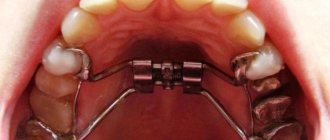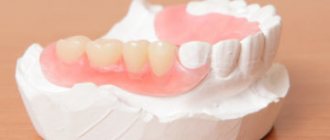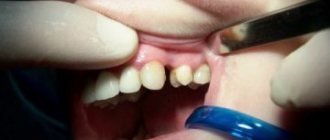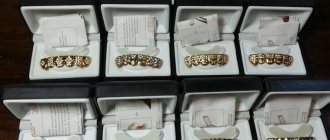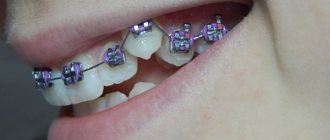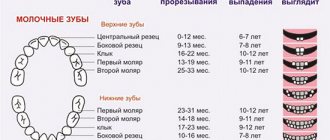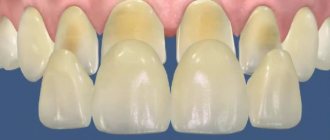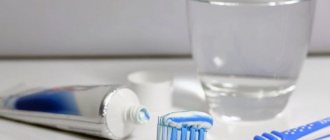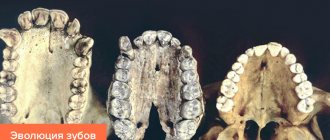All parents rejoice at every new tooth their baby has, but at the same time, teething is a lot of trouble and worry. The fact is that cutting teeth cause torment for a child, especially when it is time for fangs to appear. In some cases, parents even have to see a doctor. Why is the eruption of fangs accompanied by painful symptoms and how to survive this period? Find the answer in this article.
- 2 Teething
- 3 Eruption of fangs in children
- 4 What symptoms indicate the imminent appearance of fangs?
- 5 Fangs and hyperthermia
- 6 How to reduce painful symptoms during teething?
Baby teeth before birth
Children's teeth are formed even before they are born. In the womb, the strength of teeth, their health and appearance are determined. This happens at the beginning of the second trimester of pregnancy.
And here it is very important that the expectant mother takes care of herself and monitors her health. The more carefully she follows the regime, the stronger the child’s teeth will be. The formation of healthy teeth is impossible without calcium . There should be plenty of it in the mother’s body. This can only be achieved with proper and healthy nutrition. A pregnant woman's diet should include foods such as milk, fish, and seafood. You can also ask your gynecologist to prescribe special medications with a high calcium content.
It is worth paying attention to the fact that even with a lack of calcium in the mother’s body, the growing child will still take the necessary microelements, but at the same time will deplete the mother’s body. There will be a deficiency of calcium and potassium in the mother's bones and teeth, which will ultimately have a negative impact on the health of the fetus.
In the vast majority of cases, babies are born without teeth . In very rare cases, doctors discover central incisors in newborns in the delivery room. This phenomenon is considered an anomaly associated with excess calcium in the mother’s body or genetic characteristics.
If teeth erupt late
Teething gum gel for babies
Often, inexperienced parents, having noticed signs of the appearance of the first dental units in the baby, begin to worry about whether an infant can cut teeth at 3 months. Also, many mothers and fathers are worried that their 6-month-old baby does not yet have a single tooth.
Teething in a newborn is influenced by factors such as:
- Development of rickets;
- Weakening of the immune system;
- Failure of the endocrine system;
- Unbalanced diet, late complementary feeding;
- Prematurity;
- Insufficient amount of calcium in the body;
- Problems in the functioning of the gastrointestinal tract;
- The rudiments of baby teeth are missing.
Teething baby
Teething
The central incisors begin to emerge first . Moreover, the time of their appearance is different for different children. In some babies they begin to climb at 3-4 months, in others they appear only at one year of age. Moreover, the incisors may not fit in the order that doctors are accustomed to.
Very often, parents mistakenly think that excessive drooling in children is due to the fact that the first teeth are starting to cut. In fact, the abundance of saliva is most often associated with the release of the salivary glands at full capacity. Babies at an early age do not know how to swallow saliva well, so it flows out of their mouth.
You can understand that the first teeth have begun to emerge by looking at the child’s gums. on the lower gum or its front edge swells. It is at this time that the baby begins to put everything in his mouth. He develops a desire to bite toys and his parents’ fingers, loses sleep and loses his appetite.
The first teeth begin to emerge in the following order:
- Central incisors.
- Extreme incisors. They begin to emerge almost immediately after the central incisors.
- Permanent teeth. They are cut one on each side.
- Fangs.
In the first months of a child’s life, not only the eruption of the first teeth occurs, but also the formation of permanent ones . And even though they will begin to grow only after a few years, you need to start taking care of them already at the beginning of the baby’s life. This concern should be expressed in providing the child with adequate nutrition.
The best food for your baby to keep his teeth healthy is breast milk . During breastfeeding, mothers should eat foods rich in calcium. When a mother cannot breastfeed, she needs to choose good artificial nutrition for feeding.
It is very important to introduce complementary foods on time to ensure that the first teeth are strong and healthy.
If parents want their child’s first and permanent teeth to be strong, they should know that not to give sweets to the baby . A child can get all the necessary sugars from fruits. You should also not give your child packaged juices. They contain a lot of preservatives and sweeteners.
When the first teeth erupt, parents wonder how they can help their child? And here the doctors have an unequivocal answer - the baby’s teeth should cut on their own. When parents make any efforts to speed up this process, the teeth may come out damaged. Moreover, there is a possibility of some kind of infection in the jaw bone.
How to fix protruding fangs on a person
After all, for successful treatment all you need is:
- carry out diagnostics correctly;
- correctly interpret diagnostic data;
- determine the cause of the canine(s) located on top.
And in this matter we have both vast experience and our own professional secrets.
Diagnostics is the first and key step in the treatment of protruding fangs. Do you want to know why it’s impossible to do without diagnostics?
The main “secret” and “trick” of our team is high-quality diagnostics and an analytical, thoughtful approach to the treatment of any malocclusion. This ensures the success of our treatment. Including crooked fangs in an adult or child. And no magic or mysticism.
We treat protruding fangs without removal!
Very often, people turn to orthodontists with a complaint about a “protruding” (overhanging) fang. On one or both sides. This is understandable... such a “pendant” does not add beauty to a smile.
Unfortunately, not all of our colleagues do not always correctly understand the reason for this position of the fangs and often act very straightforwardly - removing the tooth behind (the first premolar) in order to put the canine in place. An example is shown in the video.
And if there are gaps left, they are simply simply “tightened” (closed) with special elastic bands. First of all, this is essentially wrong. Because without understanding the reasons, there is no point in doing anything. Moreover, to delete something.
And secondly, it can have consequences (read the article “About treatment with removal”).
We used to treat this way too...
- “Protruding” upper right canine. View from below. It is clearly visible that the right lateral teeth are shifted anteriorly and the frontal teeth (incisors) are rotated counterclockwise - all this creates a shortage of space for the right canine.
- After an attempt to place the canine in an arch with braces (without understanding the reasons for the lack of space for the right canine), the decision was made to remove the right first premolar.
- After extraction of the right first premolar.
- After closing the gap from the extracted premolar. There is a clear asymmetry of the dentition due to the different number of teeth on the right and left.
...but were always dissatisfied with the results of this approach!
Because treatment of “protruding” fangs with the removal of adjacent teeth (premolars) and further “pulling” of adjacent teeth can lead to serious complications from the nervous system. And the aesthetics also remain not up to par, for example, the central line shifts towards the extracted tooth, which leads to a “crooked” (one-sided, asymmetrical) smile (see “About treatment with extraction”).
During a direct examination by a specialist, you will be able to find out your exact diagnosis, as well as receive a referral for diagnosis or a treatment plan.
Or another option (very popular among orthodontists): without understanding what’s what, what is the reason for the incorrect position of the fang, orthodontists simply “install” braces (unreasonably relying on their capabilities) and instead of a “sticking out” fang(s), they get incisors protruding forward ( that is, their protrusion). Why be surprised: braces are just a tool. And there is no need to attribute “magical” properties to the “tool” (device). If the doctor made the wrong diagnosis, if he did not understand the causes of the problem (the same “protruding” fangs), then no braces will help.
- An attempt to place a “protruding” canine using braces led to protrusion of the upper incisors.
Now we approach the issue of treating “protruding” fangs more humanely, since we always act “targeted”, clearly defining the immediate cause of this problem.
After all, a “protruding” fang is not a diagnosis at all, but only a consequence of certain processes. And these processes have a reason. This is what we find and eliminate. This allows you to solve problems without removing teeth (which, as we believe, are never unnecessary).
What reasons lead to “protruding” fangs?
There are two main reasons, and both reasons can be combined with each other, “successfully” complement each other and manifest themselves on one or both sides.
The first reason is the anterior (mesial) shift of the lateral teeth on the side of the “hanging” canine. In this case, the lateral teeth will need to be moved back (distalized) to place the canine. For example, with such devices as shown in the video:
The second reason is the shortening of the upper jaw in its anterior part, in the so-called premaxilla, the area of the incisive bone. In this case, it is necessary to develop the upper jaw in the front part (lengthen it). For example, like this:
- “Protruding” fang BEFORE hardware development (lengthening). Side view.
- “Protruding” fang BEFORE hardware development (lengthening). View from below.
- AFTER the development (lengthening) of the upper dentition, a place appeared for the placement of the canine.
- Now you can work with braces.
With a bilateral “hanging” fang, all these processes (the causes of “protruding” fangs) are symmetrical (bilateral).
- Bilateral deficiency of space for canine teeth. BEFORE treatment.
- Correction of bilateral canine space deficiency. After treatment.
And if the fang “sticks out” only on one side, then there is a one-sided deformation of the dentition (jaw). The only difference is this.
- Unilateral lack of space for the canine. BEFORE treatment.
- Elimination of unilateral deficiency of canine space. After treatment.
If you approach the treatment of “protruding” fangs wisely (thoughtfully, adequately to the cause of the problem), then it makes no difference whether the fang did not have enough space on one side or on both sides. As a result, all teeth will stand straight and beautiful. And most importantly, no tooth extraction... No surgery. No "destructions". Everything is adequate (symmetrical to the problem and the mechanism of its occurrence). And to the point.
During a direct examination by a specialist, you will be able to find out your exact diagnosis, as well as receive a referral for diagnosis or a treatment plan.
Source: https://www.ort-art.ru/orthodontics/nerovnyie-zubyi/__torchaschie-klyiki
Eruption of fangs in children
Symptoms of the appearance of fangs are specific.
They cannot be confused with the appearance of other teeth; they appear very difficult. It is impossible to name the exact time of the appearance of fangs; the fact is that in some children the first fangs appear at 4-5 months, while in others they can emerge only at 9 months. In such a situation, doctors must be able to reassure parents who are worried that their child is developing abnormally. Doctors themselves know very well that there is no norm in teething. Moreover, in some cases the order of teeth eruption is disrupted. And the standard timing and order of appearance of teeth is nothing more than a convention. The eruption of fangs in children begins with the appearance of white spots on the gums, followed by swelling. It is noteworthy that these signs can appear even before the molars begin to grow. This is explained by the fact that the canines begin to grow along with the molars, but are somewhat delayed during eruption, allowing the molars to pass forward.
Why do fangs cause painful symptoms when they start to cut? This is explained by their anatomical features . The fangs have very long roots, which are located in close proximity to the facial nerves.
The canines on the upper jaw are often called eye teeth . At their roots there is a nerve that connects the upper part of the face with the central nervous system. When the upper fangs are cut in children, lacrimation and conjunctivitis from the problematic tooth are added to the painful sensations.
Lower canines cause less trouble when teething. Unfortunately, it almost never happens without side effects.
Timing and sequence
Signs of teething in a 4 month old baby
All children develop teeth on their own individual schedule. If parents are concerned about the question of whether a baby can cut teeth at 3 months, then the answer is yes. In many children, the first teeth can be seen at 6 months. It happens that they begin to emerge very early (at 3 months) or late (at 10-12 months).
Additional Information. If the baby is already one year old and does not yet have a single tooth, you need to contact your pediatrician. You may also need to consult a dentist to determine the presence of developmental pathology.
Standard pattern for the eruption of primary teeth in the lower jaw
| Name of teeth | Timing of eruption |
| Central incisors | 8-12 months |
| Lateral incisors | 9-13 months |
| First molars | 13-19 months |
| Fangs | 16-22 months |
| Second molars | 2-3 years |
Standard pattern for the eruption of primary teeth in the upper jaw
| Name of teeth | Timing of eruption |
| Central incisors | 6-10 months |
| Lateral incisors | 10-16 months |
| First molars | 1.5-2 years |
| Fangs | 1.5 years |
| Second molars | 2-3 years |
Additional Information. If babies cut their first teeth at 3 months, these should be the front incisors. If the molars appeared first, a consultation with a dentist is necessary to find out if there are any pathologies.
First teeth
What symptoms indicate the imminent appearance of fangs?
The symptoms of teething cannot be called specific. It is similar to the symptoms of the appearance of other teeth:
- The child's salivation increases, which is often accompanied by irritation around the mouth.
- The gums become swollen and red.
- The child begins to put everything in his mouth. Thus, he tries to cope with itching in the gums.
- Insomnia comes.
- The baby refuses to eat.
- Irritability appears.
Doctors have long noted the connection between the severity of teething symptoms and the overall health of the child. The healthier the baby, the fewer side effects teething will bring. If you have a weakened immune system, the following will come with your teeth:
- Runny nose.
- Hyperemia of the mucous membranes of the mouth.
- Temperature.
An experienced doctor can easily distinguish a runny nose during teething from an infection and will prescribe homeopathic and immunomodulatory remedies for the baby to combat cold symptoms.
When the appearance of fangs is accompanied by symptoms of an intestinal infection, it is recommended to get tested.
How are eye teeth and fangs related?
Many parents have heard that the first tooth is complete nonsense. As soon as the eyes go bad, then you will have to suffer. What teeth are called this?
The canines on the upper gum are otherwise called eye canines. Why? They owe this name to their location - near the optic nerves. Multiple branches connect the upper face and the central nervous system. If these nerves are very close to the gums, the eruption of the upper canines in a child is accompanied not only by moodiness and refusal to eat, but also by lacrimation. Doctors diagnose some babies with conjunctivitis.
Fangs and hyperthermia
Many parents confuse teething and illness. Or rather, they put an equal sign between them. This cannot be done. Of course, under ideal conditions the temperature should not rise when fangs appear, but life is far from ideal, so hyperthermia is observed in most children . There is no need to worry about this case, unless the fever reaches 38 ° C. If the temperature is high, you should definitely call a doctor to rule out or confirm the presence of infection. As a rule, experienced pediatricians, if the increase in temperature is caused by the eruption of fangs, advise bringing it down when it rises above 38 °. The following drugs are best suited for this:
- Paracetamol for children.
- Ibuprofen.
- Nurofen in suppositories.
- Cefekon.
If hyperthermia persists for several days, it is recommended to call a doctor again.
What help can be provided to a child at home?
Since the child's body experiences a certain amount of stress when teething, it is quite natural that his immunity weakens and he becomes more susceptible to viruses. The baby may experience increased tearing, swelling of the nasopharynx and sore gums.
If your nose is leaking...
The appearance of viscous or liquid green discharge should definitely attract the attention of parents. If such a nuisance happens to your baby’s nose, then it is advisable to keep several types of vasoconstrictor drops and nasal rinses in your home medicine cabinet.
The composition of drugs such as Aquamaris, Humer and Marimer includes salted sea water, so they are absolutely safe for children of any age.
Drugs such as Nazivin, Nazol baby and Otrivin also work well for nasal congestion. Despite the fact that they are sold in any pharmacy, it is still not recommended to use them as a medicine without first consulting a doctor.
How to reduce fever and eliminate pain
Antipyretics based on Ibuprofen and Paracetamol are the safest for a small organism. Moreover, the best option is liquid syrups and rectal suppositories with different active ingredients.
Sometimes it is quite problematic to bring down a high body temperature at home; in such cases, urgent hospitalization is needed.
For quick pain relief, local gels are applied to the inflamed areas. Their anesthetic properties temporarily block pain. Kalgel, Dentinox, Kamistad and other drugs similar in composition are sold in pharmacies without a prescription.
Homeopathy also does not stand aside and offers its own alternative solutions. Despite the fact that Dentokind tablets are cumulative-action drugs, the effect of their use occurs almost immediately.
Replacing temporary canines with permanent ones
The milk bite is replaced by a permanent one gradually, starting from the bottom row. The incisors fall out first (first the front ones, then the lateral ones).
As for the fangs, they completely change to permanent ones by the age of 10-12 years. But replacement, just like teething, does not always follow a clearly established pattern.
Teeth can fall out in a completely different order, and the task of parents at this stage is to keep this process under control. When changing your bite, you must periodically visit the dentist, who will observe how the teeth behave during replacement.
There are situations when baby teeth, firmly seated in the jaw, prevent the molars from fully developing. After the doctor is convinced of the advisability of removing temporary teeth and carries out all the manipulations, enough space will be freed up in the jaw and the teeth will not have to crowd each other.
Early tooth loss requires no less close attention. The remaining dentition gradually shifts and takes up the vacated space, thereby preventing the formation of a correct permanent bite. Such problems are successfully solved by orthodontic dentistry.
"Ambulance" without pills
Of course, it is good to have a sufficient amount of medicines on hand. But what if there are no drugs in the home medicine cabinet that are appropriate for the child’s age? Is it possible to alleviate the suffering of a baby who is growing fangs without anesthetics and anti-inflammatory medications?
If the child’s body temperature remains within normal limits, then the following methods will come to the mother’s aid.
Gum massage
To perform this, your hands must be clean. You need to start with gentle stroking, trying not to touch areas of increased pain.
As soon as the child understands that they want to help him and gradually relaxes, the mother’s finger will have a chance to gradually reach the inflamed area and gently massage it.
Alternating movements of varying degrees of intensity will bring relief to small teeth that are just beginning their journey.
Teethers
The shape of these products will undoubtedly attract the little explorer, and he will want to taste unfamiliar objects. With their help, it will be convenient for your baby to scratch his reddened gums.
Many teething toys are filled with water, so they can be stored in the refrigerator until completely cooled, and then given to the baby's hands.
As you know, cold has a calming effect, and the uneven surface of the teether produces an additional massage effect.
In the event that a child becomes lethargic and inactive, vomits repeatedly or has problems with bowel movements, you should not self-medicate and waste precious time! If it is not possible to get to the hospital on your own, then you need to call an ambulance as soon as possible. The life and health of young children very often depend on just a few minutes, which adults prefer to spend thinking rather than saving.
